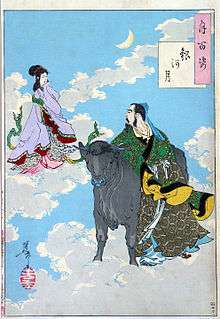The Weaver Girl and the Cowherd
The Weaver Girl and the Cowherd is a Chinese folk tale.
The general tale is a love story between Zhinü (織女; the weaver girl, symbolizing Vega) and Niulang (牛郎; the cowherd, symbolizing Altair).[1] Their love was not allowed, thus they were banished to opposite sides of the Silver River (symbolizing the Milky Way).[1][2] Once a year, on the 7th day of the 7th lunar month, a flock of magpies would form a bridge to reunite the lovers for one day.[1] There are many variations of the story.[1] The earliest-known reference to this famous myth dates back to over 2600 years ago, which was told in a poem from the Classic of Poetry.[3]
The tale of The Weaver Girl and the Cowherd has been celebrated in the Qixi Festival in China since the Han dynasty,[4] in the Tanabata festival in Japan, and in the Chilseok festival in Korea. The story is now counted as one of China's Four Great Folktales, the others being the Legend of the White Snake (Baishezhuan), Lady Meng Jiang, and Liang Shanbo and Zhu Yingtai. [5]
Literature

The tale has been alluded to in many literary works. One of the most famous one was the poem by Qin Guan (1049-1100) during the Song dynasty:
| “ | 鵲橋仙
Meeting across the Milky way
|
” |
Cultural references

Reference to the story is also made by Carl Sagan in his book Contact. The tale and the Tanabata festival are also the basis of the Sailor Moon side story entitled Chibiusa's Picture Diary-Beware the Tanabata!, where both Vega and Altair make an appearance. The Post-Hardcore band La Dispute named and partially based their first album, Somewhere at the Bottom of the River Between Vega and Altair, after the tale. The JRPG Bravely Second: End Layer also uses the names Vega and Altair for a pair of story-important characters who shared a love interest in each other years before the game's story began.
Notes and references
- 1 2 3 4 Brown & Brown 2006, 72.
- ↑ Lai 1999, 191.
- ↑ Schomp 2009, 89.
- ↑ Schomp 2009, 70.
- ↑ Idema (2012), p. 26.
- ↑ Qiu 2003, 133.
Bibliography
- Brown, Ju; Brown, John (2006). China, Japan, Korea: Culture and customs. North Charleston: BookSurge. ISBN 1-4196-4893-4.
- Idema, Wilt L. (2012). "Old Tales for New Times: Some Comments on the Cultural Translation of China's Four Great Folktales in the Twentieth Century" (PDF). Taiwan Journal of East Asian Studies. 9 (1): 25–46.
- Lai, Sufen Sophia (1999). "Father in Heaven, Mother in Hell: Gender politics in the creation and transformation of Mulian's mother". Presence and presentation: Women in the Chinese literati tradition. New York: St. Martin's Press. ISBN 031221054X.
- Qiu, Xiaolong (2003). Treasury of Chinese love poems. New York: Hippocrene Books. ISBN 9780781809689.
- Schomp, Virginia (2009). The ancient Chinese. New York: Marshall Cavendish Benchmark. ISBN 0761442162.
Further reading
- Mao, Xian (2013). Cowherd and Weaver and other most popular love legends in China. eBook: Kindle Direct Publishing.